|
1. The first pilot study was developed 30 years ago with a music therapist and involved sending out 50 two-part questionnaires. 100% of the participants perceived they were more relaxed after listening to the music even if they had indicated they would not choose to listen to harp music if given a choice. This challenged the idea that a person has to like the music in order for it to be effective.
2. A Quantitative EEG Pilot Study with the "New Love" CD, conducted by William Collins, PhD, indicated the music induced a state of relaxation in 4 minutes by increasing alpha wave and decreasing beta wave frequencies in the brain in 5 subjects. This pilot study became the impetus to form the Scientific Arts Foundation. Here is the summary:
* A pilot study was conducted of five adults between the ages of 22 and 51 years.
* Quantitative EEG measurements were taken with the eyes closed without music and then while listening to New Love "awaken to yourself" for 4 minutes.
* Results showed an increase in alpha waves in 100% of the subjects and a decrease in beta waves in 4 of the 5 subjects after 4 minutes of listening to New Love "awaken to yourself". (see graph)
* Alpha waves are associated with the self-regulation of stress and a decrease in sympathetic nervous system arousal resulting in a state of relaxation.
* The combination of these two factors (increase in alpha waves and decrease in beta waves) can contribute to increase effectiveness of the immune system
. 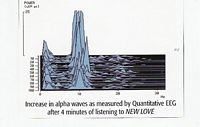
3. "Effects of the New Love solo harp CD on Alpha Frequency" pilot study indicated the music was effective for both 'right brain' and 'left brain' thinkers as measured by Quantitative EEG. Conducted by William Collins, PhD.
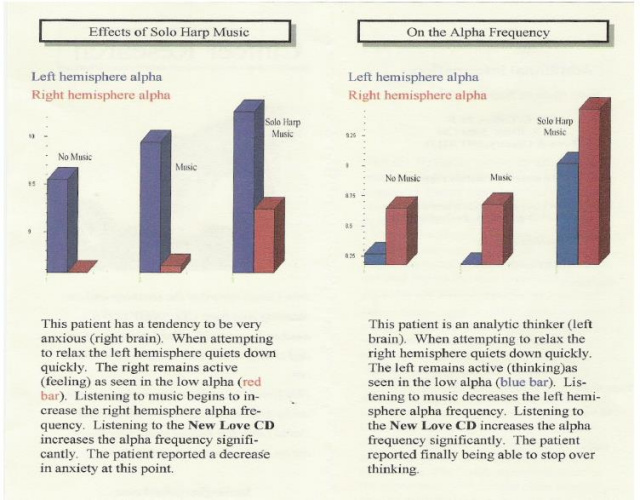
4. “Effects of a Relaxation CD on Stress Factors in Cancer Patients Receiving Chemotherapy as Measured by Quantitative EEG: A Pilot Study” by William Collins, PhD
A Quantitative EEG Pilot Study with "The Magic Mirror" CD indicated listening to the music once a day for 10 days had a direct positive impact on neurological functioning in women undergoing chemotherapy treatment for cancer. Learn more...
PRE-QEEG Images POST-QEEG Images
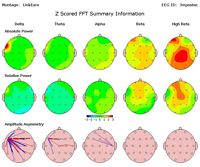 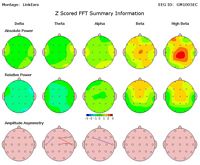
5. “Effect of Music on Psychoneuroimmunological Responses”
Conducted by David Kossor, RPh, PhD and Abdul Waheed, PhD
Two Saliva Sample Pilot Studies with 17 healthy individuals indicated listening to "The Magic Mirror" CD once had a sustained impact on immune system biomarkers for up to 72 hours. These results suggest that this music is very effective and could be used in combination with other therapy for cancer or physiologically stressed patients to minimize the effect of their disease. Learn more
PUBLICATION OF ABOVE PILOT STUDIES
6. “A Randomized Study of the Effects of Two Relaxation Music CDs on Stress Factors in Adults Receiving Chemotherapy as Treatment for Cancer” - designed, IRB Approved, Not Yet Implemented
The Scientific Arts Foundation has authored a medically approved (through an Institutional Review Board), multi-site, wholistic clinical trial with neurological, biological, standardized psychological, quality of life and environmental measurements. This study explores the impact of "The Magic Mirror" solo harp CD and Steven Halpern's "Comfort Zone" solo piano CD on stress factors in adult cancer patients receiving chemotherapy treatment for cancer. Specific measurements include:
1) Quantitative EEG for neurological functioning
2) Saliva secretory IgA, IgG, cortisol, secretory carbonic VI, and a-amylase as immune
system biomarkers
3) A short daily questionnaire to track quality of life and psychological changes
4) A standardized psychological questionnaire given at the beginning and end of the study to measure psychological state, and daily life functioning
5) A one-time general questionnaire to determine musical preferences, support systems, personality type and their belief/perception of their situation
6) A Case Report Form will track gender, the type /stage of cancer and chemotherapy
drugs used
7) A short one-time questionnaire for Groups 1 and 2 describing the participant’s selected listening space. This will offer insight into possible environmental influences that may affect the listening experience. Measurements will begin upon diagnosis and continue until one month into treatment.
This study has not been funded or implemented to date.
7. "New Love," "Love and Gratitude," and "The Magic Mirror" solo harp CDs are part of a pilot study exploring the Epigenetic Environmental conditions of a medical clinic in Tennessee. This study was developed by Deborah Burnett, ASID. Learn more...
8. A Quantitative EEG pilot study, conducted by William Collins, PhD, with "DREAMS-the love within" solo harp CD indicated that the music produced a relaxed mental state in all 5 subjects measured. The design of the study involved three separate QEEG data recordings. Subjects were given a pre and post Q along with a recording while listening to the solo harp music for 27 minutes. The clearest and most significant changes were noted during the listening of the solo harp music. In all five subjects the dominant brainwave frequency was in one of the two central relaxed frequencies. The first was the high alpha frequency, between 11 and 12 hz and the second was the SMR (Sensory Motor Response) frequency between 12 and 15 hz. The high alpha frequency is associated with focused relaxed attention and the SMR frequency is correlated with muscle relaxation. This CD will be available Summer 2008.
9. I played lap harp at St. John's Mercy Medical center every week for 1 1/2 years for inpatients on the oncology floor as part of the hospital’s Healing Therapies Pilot Study Program taking pre and post Pain and Distress levels. Over 99% of responses indicated less pain and distress after just 10 minutes of my live harp music.
10. I personally listened to "The Magic Mirror" CD twice a day upon my diagnosis of Stage 2 breast cancer and continued listening to this CD every day during my treatment. QEEG was gathered twice, at the end of 6 chemotherapy rounds and again one week after completing 33 radiation treatments.
Comments from William Collins, Ph.D:
In the second QEEG, we see an improvement in cognitive function despite the fact that we would expect to see more cognitive deficits than the previous QEEG.
In the second QEEG the increase of alpha frequency was being generated by the parahippocampus (brodman 28 area) which is a deep center of the brain and part of the emotional memory system. This is a clear indication of the music affecting deep centers of the brain.
The image below shows the source location for the generation of the Alpha frequency in the second QEEG recording. This system of analysis is done by a program called LORETA (Low Resolution Electromagnetic Tomagraphy). It is a complex analysis of EEG placed over an MRI template in order to locate the source of any cortical EEG. The specific regions of the brain involved in this source location of parahippocampus (Brodmann 28) which is part of the limbic system. Brodmann 28 is a part of the emotional memory system.

I believe music from "The Magic Mirror" CD is reaching deep inside the brain and positively impacting my emotional memory system which helped to prevent any symptoms of cognitive deficits or 'chemobrain'. I posed the question to Dr. Collins and this was his response:
Q: Does The Magic Mirror help to reduce the impact of chemobrain, fatigue, stress and anxiety?
A: It would require futher investigating to unequivocally determine that The Magic Mirror is in fact reducing the impact of these things, however the evidence shows it does allude to the reduction in symptoms.
Here is an interesting link to explore more research looking at Brodmann 28: https://theamazingworldofpsychiatry.wordpress.com/tag/brodmann-area-28/
Below are more images from my second QEEG session. The QEEG data was analyzed by Dr. Robert Thatcher’s normative database (NeuroGuide). William Collins, PhD, commented that I was "abnormally normal" in that he had never seen such a balanced QEEG in the 17 years of his practice:
Eyes Open: Eyes Closed:
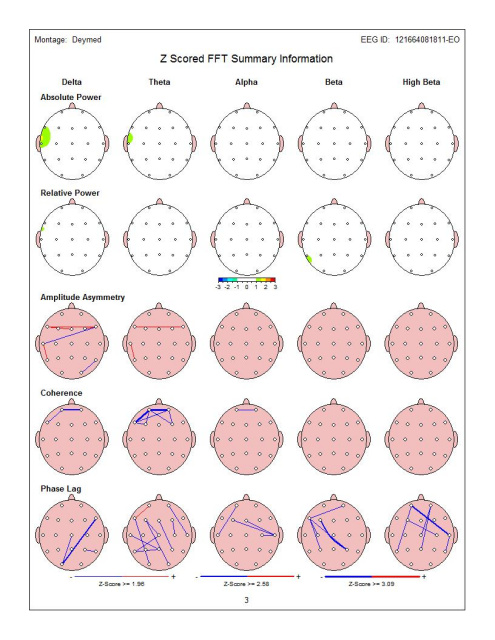 
Summary of 2nd QEEG Session:
The second quantitative EEG recording shows a significant elevation in the Alpha frequency (from the first recording) and an increase in beta frequency which is related to active focus attention. The beta frequency is the frequency that is involved in most cognitive processing. This recording again was done one week after the 33rd radiation treatment.
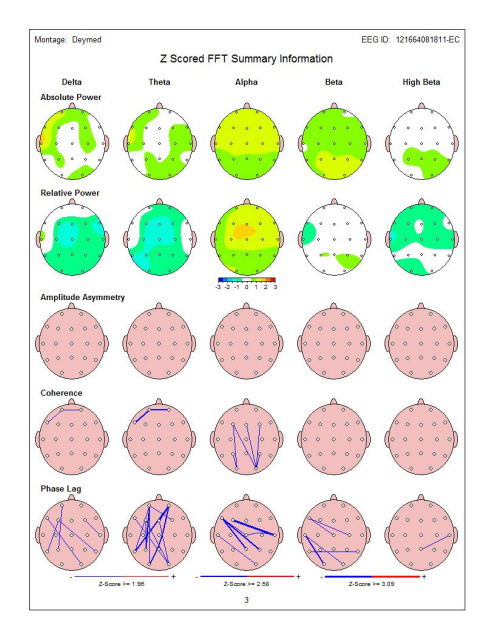
11. Pediatric Pilot Study with The Magic Mirror CD
Conducted by Dr. Anu French, research assistant Kristy Shaughnessy, and Dr. William Collins
Comments by Dr. French: "Our pilot study on ‘The Magic Mirror' harp music (by Amy Camie, Harpist) as a cost-effective biofeedback/neurofeedback tool to relieve stress, build intergenerational resilience and teach self-regulation, was well received at the AAP’s Section On Integrative Medicine Session!
Thanks to SOIM research grants from the AAP/MPPPA and hard work by Kristy Shaughnessy, our wonderful research assistant, we showed positive outcomes in resilience and QOL (quality of life) scores and calming of QEEG brainwave patterns supporting our hypothesis that this healing music by Amy Camie has powerful psychoneuroimmunological effects to help reverse inflammation/toxic stress."
Results were presented at the American Academy of Pediatrics Annual Conference in Orlando, FL
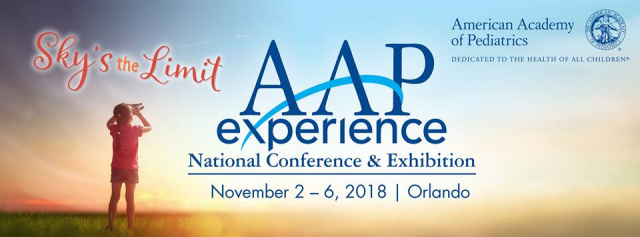
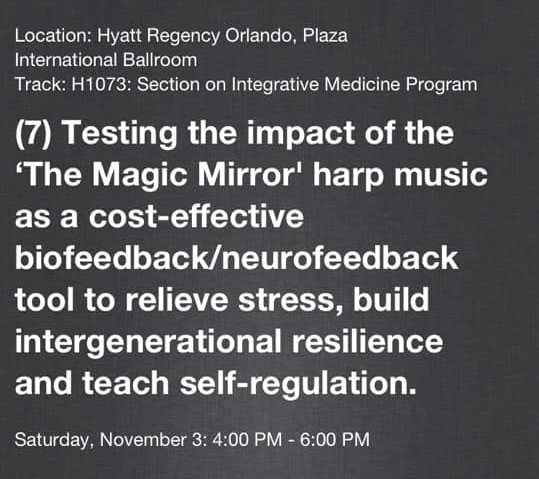
CLICK HERE to see full Poster Presentation
12. A Clinical Trial was approved through Washington University School of Medicine to be implemented through Siteman Cancer Center in St. Louis, Missouri:
"The Effect of 23 minutes of Distinctive Therapeutic Solo Harp Music on Anxiety in Newly Diagnosed Adult Patients Scheduled to Receive Chemotherapy Treatment for Cancer: A Feasibility Study"
This study was closed on Oct. 15, 2021 due to lack of funding during COVID.
Click image below to read an overview of what this study was exploring:

|